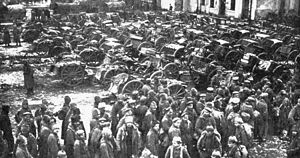Battle of Tannenberg
| Battle of Tannenberg | |||||||
|---|---|---|---|---|---|---|---|
| Part of the Eastern Front of World War I | |||||||
 Russian prisoners of war after the Battle of Tannenberg. |
|||||||
|
|||||||
| Belligerents | |||||||
|
|
|
||||||
| Commanders and leaders | |||||||
|
|
|
||||||
| Units involved | |||||||
|
|
|
||||||
| Strength | |||||||
| 150,000 | 230,000 | ||||||
| Casualties and losses | |||||||
|
10,000–15,000 killed or wounded 13,873: 1,726 KIA 7,461 WIA 4,686 MIA |
170,000: 78,000 killed or wounded 92,000 POW 350 guns captured |
||||||
10,000–15,000 killed or wounded
12,000 killed or wounded
The Battle of Tannenberg was fought between Russia and Germany from 26–30 August 1914, during the first month of World War I. The battle resulted in the almost complete destruction of the Russian Second Army and the suicide of its commanding general, Alexander Samsonov. A series of follow-up battles (First Masurian Lakes) destroyed most of the First Army as well and kept the Russians off balance until the spring of 1915. The battle is particularly notable for fast rail movements by the Germans, enabling them to concentrate against each of the two Russian armies in turn, and also for the failure of the Russians to encode their radio messages. It brought high prestige to Field Marshal Paul von Hindenburg and his rising staff-officer Erich Ludendorff.
Although the battle actually took place near Allenstein (Olsztyn), Hindenburg named it after Tannenberg, 30 km to the west, in order to, in German eyes, avenge the defeat of the Teutonic Knights 500 years earlier at the Battle of Grunwald (which was always known as the Battle of Tannenberg in German).
The French army's Plan XVII at the outbreak of World War I involved swift mobilization followed by an immediate attack to drive the Germans from Alsace and Lorraine. If the British Expeditionary Force (BEF) joined in accordance with their Allied treaty, they would fill the left flank. Their Russian allies in the East would have a massive army, more than 95 divisions, but their mobilization would inevitably be slower. Getting their men to the front would itself take time because of their relatively sparse and unreliable railway network (for example, three-quarters of the Russian railways were still single-tracked. Russia intended to have 27 divisions at the front by day 15 and 52 by day 23, but it would take 60 days before 90 divisions were in action. Despite their difficulties, the Russians promised the French that they would promptly engage the armies of Austria-Hungary in the south and on day 15 would invade German East Prussia.
...
Wikipedia
